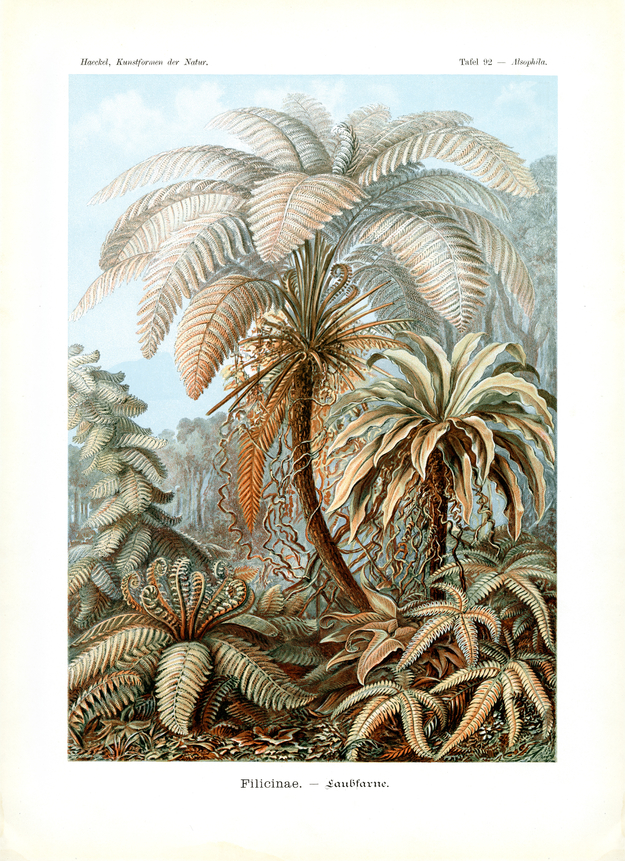Translation of the original German introduction by Ernst Haeckel:
Division of Diaphyta or Archegoniata (Vorkeimpflanzen); - main class of Pteridophyta (Farnpflanzen); - class of Filicinae (Laubfarne).
–
Part of “Art Forms of Nature” with a modest role in our temperate climate but an outstanding one in hot, tropical zones is the most varied main class of ferns, and among them especially the bigger forms of ‘leave-fern’. While in our moderate climate the beautiful, tenderly leaved “vessel-cryptogamae” are available only in the form of small or medium-sized herbs but never in ascending tree-like forms, in humid greenhouse climate they live as a variety of ‘fern-trees’, competing with palm trees when it comes to the impressive growth of the slender stem and the beauty of its foliage; individual leaves of some of the herb-like, stem-less ferns (Angiopteris) reach a length of more than 4 meter while the stalks have a thickness of 10 cm. In between these giants bulks a mass of smaller and tiny ferns makes the green carpet of the jungle ground appear to be composed of them alone. This holds true especially for the ‘eternally’ moist “rain forests” that cover the volcanic mountains of Insulinde at a height of 1000 to 2000m; in a short stretch of land and within short time one can collect more than hundred different ferns, most tiny ones among big and medium-size varieties. The dwarf-like varieties of ‘veil-ferns’ (Hymenophylleae) in particular are most often smaller than the related ‘leaf-moss’.
A typical character sketch of such a tropical fern forest of Insulinde is given on plate 92, drawn true to nature, on 4. January 1901 near the waterfall of Tjiburrum in Java. The narrow basin at the foot of the Pangerango volcano is surrounded on both sides by about 130m high, almost vertically rising rock walls with three magnificent waterfalls cascading down. The air is filled with ‘water-dust’ providing, under the refracted rays of the warm tropical sun, the most congenial conditions for the always thirsty Filicinae to ensure lush and rich development. All other forms top the splendid ‘tree-ferns’ of the division of Alsophila. On top of a slender, straight or lightly bent stem of about 12 – 15 m height a magnificent crown unfolds, composed of 20 – 30 huge fronds; the young, not yet developed leaves stand in the centre of the crest, spirally coiled; the old, dead leaves and stalks hang down from below like a bush of brown hair (in the centre of the image). The noble palms are usually called the “princes of the kingdom of plants”, Principes plantarum; the ‘tree-ferns’, however similar, surpass them in numerous ways. Since the ‘feather-leaves’ of most palm trees present simple, lance-shaped leaves of rigid, leather-like consistency, the tender feathers of ‘tree-ferns’ are again numerously feathered and divided into innumerable, most minute leaves; their delicate, light green foliage is so tender and transparent that part of sunrays shine through. The stem, coloured in brown or black, is usually delicately paneled or scaled.
Near the waterfalls of Tjiburrum – as well as in the neighbouring jungle of Tjibodas – thrives in most striking opulence and abundance the peculiar ‘bird-nest-fern’ (Asplenium nidus, to the right in the centre of the illustration). A regularly, often half-rounded crest is formed by a tuft of very numerous, tongue-shaped leaves that grow upwards in graceful arc and curve down on the outside; they reach a length of more than 1 m, at times 2 m. The centre of this giant crest forms the shape of a funnel in which rain water and falling leaves of the trees collect. Their decomposition generates rich humus which houses many articulate animals, insects, spiders and centipedes as well as giant, purplish earthworms of 30 cm length and a thickness of 1,5 cm. Below the crest of leaves a bush of dead, brownish-black leaves and mouldered leaf nerves is hanging down. Thousands of these huge, green “bird-nests” are resting on branches of the tree stems or on the vines that swing from one tree to another; at times an individual “bird-nest” crowns the top end of a broken tree stem and creates the appearance of a peculiar kind of ‘tree fern’ (so in our illustration).
In all tropical regions, just below the smaller ‘fern-herbs’, the tender four-eared ‘seam-fern’ (Pteris quadriaurita, below right) is quite common; its stalks and leaf nerves are coloured in a beautiful red with the green leaves frequently taking this colour in manifold shades. The crest of a stately Angiopteris spreads on the ground most gracefully (below left). The tree stems are usually covered with the fronds of a beautiful Polypodium hanging down, casing it like roof tiles. In between all these sprawl on the ground a good number of smaller and tiny ‘fern-herbs’. Some tender Hymenophyllum-species are smaller than the huge ‘leaf-moss’ varieties that provide a protective cover.
The tiny Monogramma resembles a small tuft of grass; a look at the backside of its delicate threat-shaped leaflets reveals a row of brown ‘spore-container’, witness to its nature as Filicinae.
Translation by VR Translators Bangalore
We've scanned the original lithography at 1200dpi on the Epson A3 scanner of A3 scanner huren. You can download a 400dpi JPEG here.
